The Role of Speckle Imaging in Exoplanet Characterization
Nic Scott
Lead Research Scientist
BAERI/NASA ARC
nicscott.org
https://www.gemini.edu/node/21236 Credit: Gemini Observatory/NSF/AURA/Artwork by Joy Pollard


Exoplanets can't hide their secrets from innovative new instrument
https://phys.org/news/2019-08-exoplanets-secrets-instrument.html
Exoplanet traced to home star in binary system
https://astronomynow.com/2019/09/05/exoplanet-traced-to-home-star-in-binary-system/
Space science research highlight: High-resolution imaging and exoplanets
https://www.nasa.gov/feature/space-science-research-highlight-high-resolution-imaging-and-exoplanets
Hidden Secrets of Elusive Exoplanet Revealed by Innovative New Instrument
https://scitechdaily.com/hidden-secrets-of-elusive-exoplanet-revealed-by-innovative-new-instrument/




1''
speckle
aperture photometry
blue
red
High-resolution Imaging Transit Photometry of Kepler-13AB -Howell et al.
Both speckle analysis and high speed aperture photometry performed with `Alopeke confirmed that the highly irratiated gas giant, Kepler-13b orbits Kepler-13A.
a single star, a circle representing the isoplanatic patch, and the small star shapes are "speckles"
a single star, a circle representing the isoplanatic patch, and the small star shapes are "speckles"
a single star, the smaller circles show worse seeing and smaller isoplanatic patches, each producing "speckles"
a single star, a circle representing the isoplanatic patch, and the small star shapes are "speckles"
a single star, the smaller circles show worse seeing and smaller isoplanatic patches, each producing "speckles"
a binary pair, close enough that they share an isoplanatic patch, producing "speckles" that correspond to their separation & position angle

a single star, a circle representing the isoplanatic patch, and the small star shapes are "speckles"
a single star, the smaller circles show worse seeing and smaller isoplanatic patches, each producing "speckles"
a binary pair, close enough that they share an isoplanatic patch, producing "speckles" that correspond to their separation & position angle
a binary pair, wherein the ratio of their separation to the isoplanatic patch size is such that their "speckles" are not correlated







a single star, a circle representing the isoplanatic patch, and the small star shapes are "speckles"
a single star, the smaller circles show worse seeing and smaller isoplanatic patches, each producing "speckles"
a binary pair, close enough that they share an isoplanatic patch, producing "speckles" that correspond to their separation & position angle
a binary pair, wherein the ratio of their separation to the isoplanatic patch size is such that their "speckles" are not correlated
Kepler-13AB








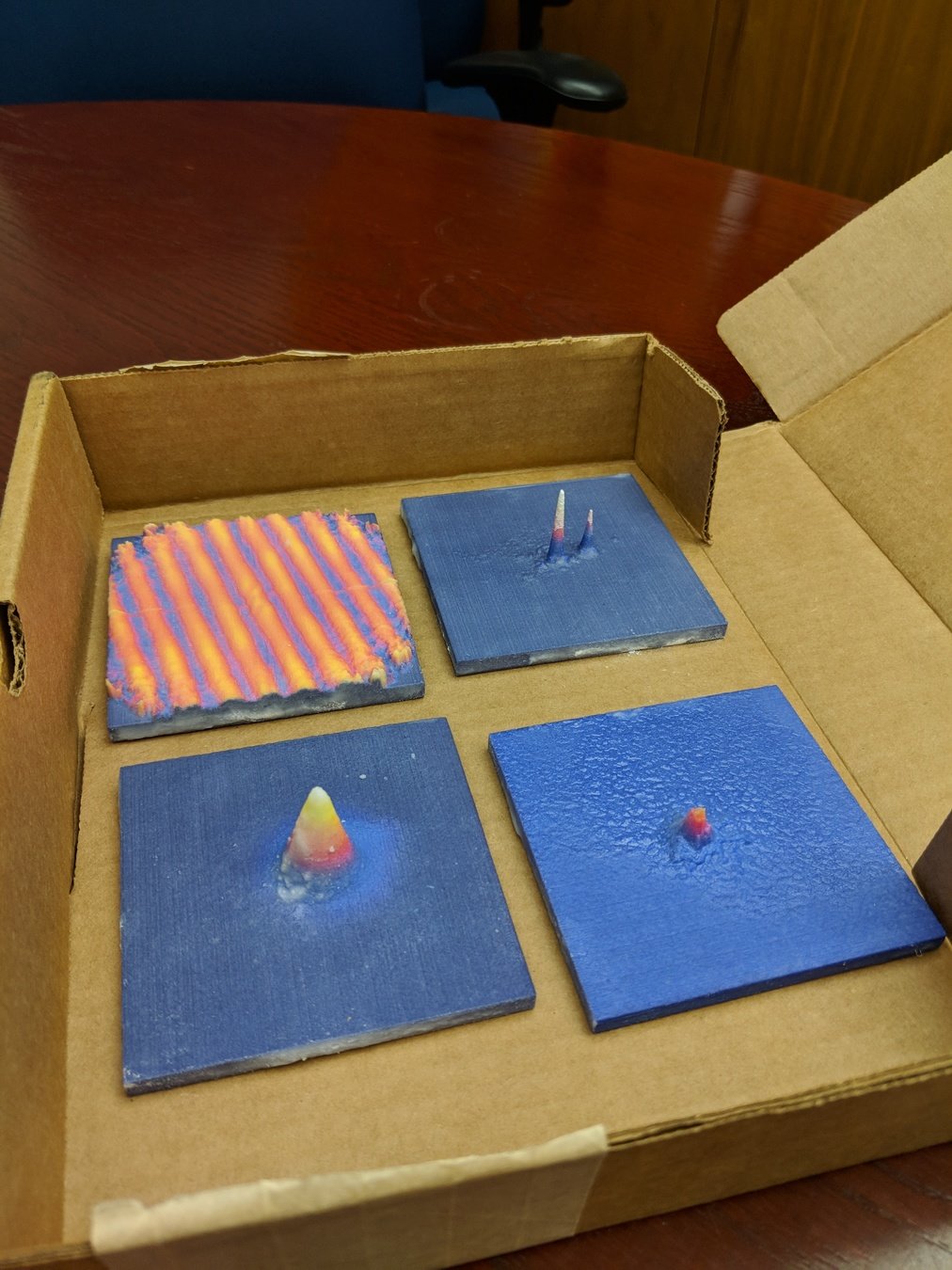


The Rayleigh criterion and the tyranny of the atmosphere
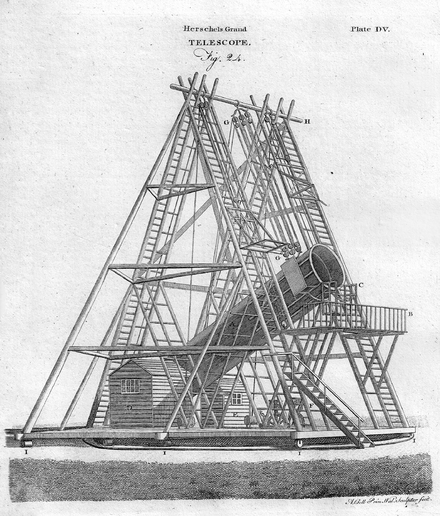

but in atmosphere, turbulent cells limit resolution to
Fizeau & Michelson
Brown & Twiss
1850s
1890s
1920 - measured Betelgeuse (with Pease)
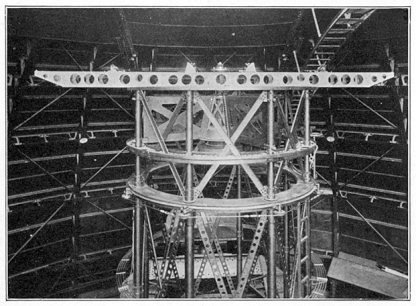
1956 - HBT effect, correlation b/t coherent photons
detail lost to the atmosphere can be regained through interferometric analysis
Intensity interferometry
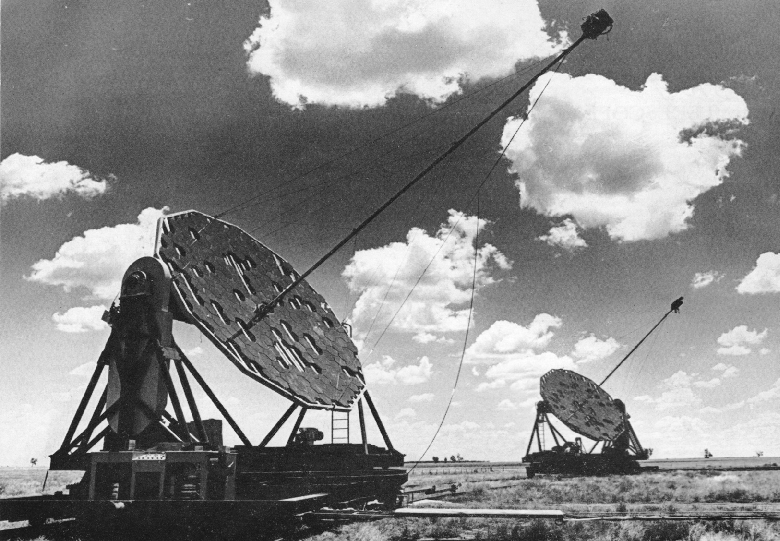
Labeyrie
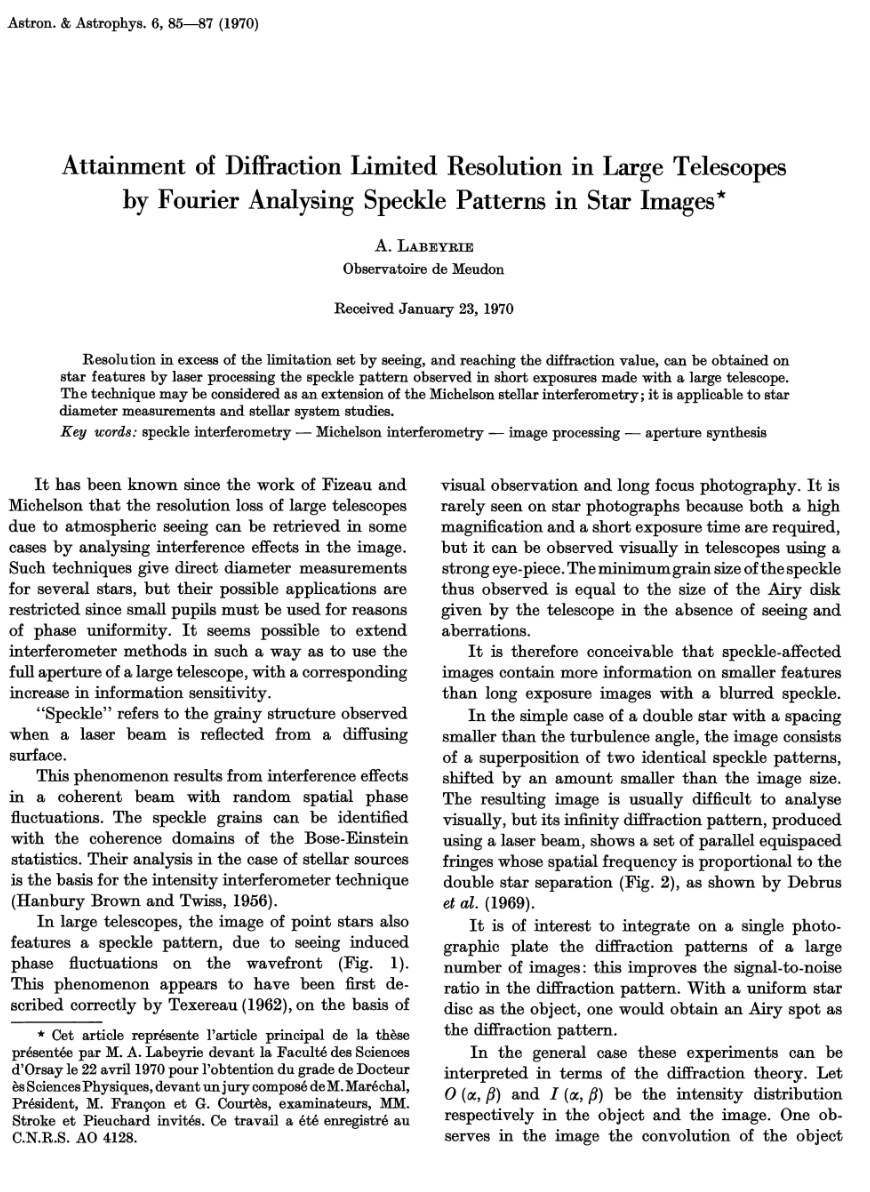
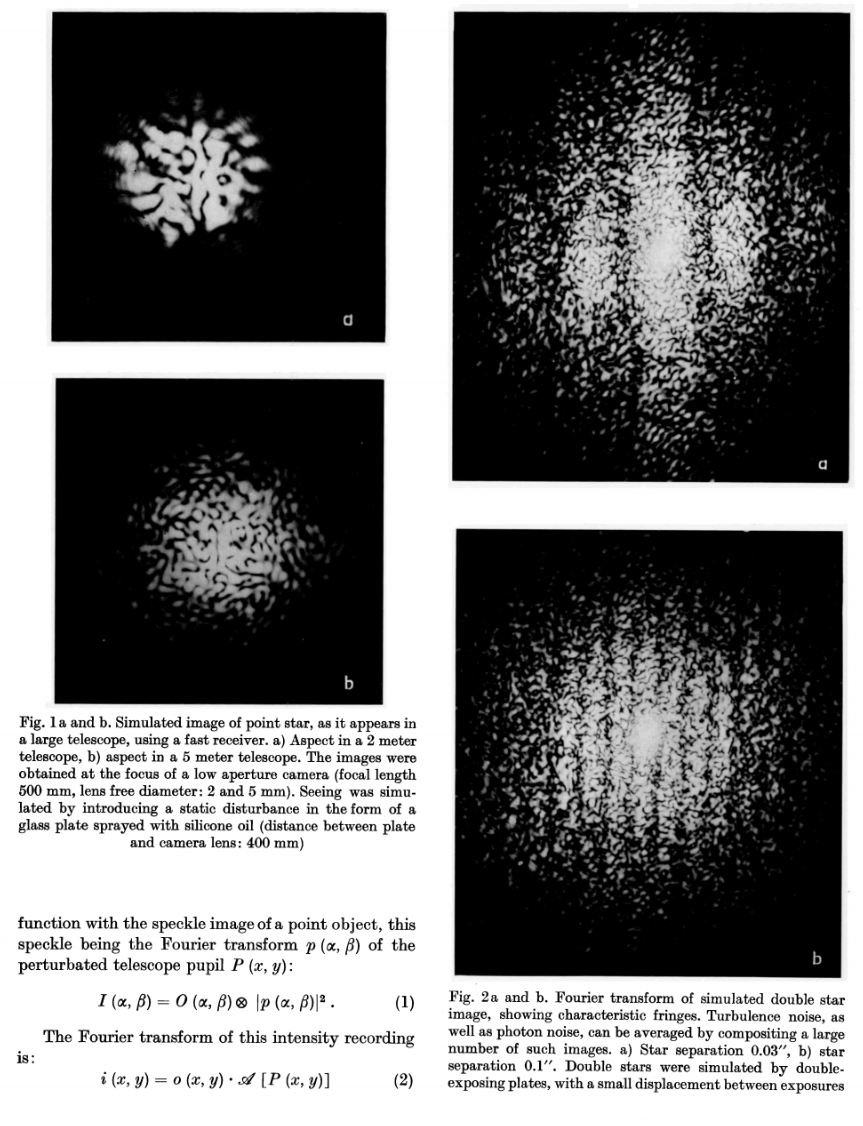
1970
Text
a method to obtain diffraction-limited resolution across the full aperture of a large telescope
long exposure
speckles blur
produce Airy pattern
true images are impossible, only centrosymmetric objects can be reconstructed
speckle pattern is the Fourier transform of telescope pupil
autocorrelation of speckles
(in Fourier space)
modulus
(time-averaged intensity)
Knox & Thompson
cross-spectrum, a 2nd order correlation
1974
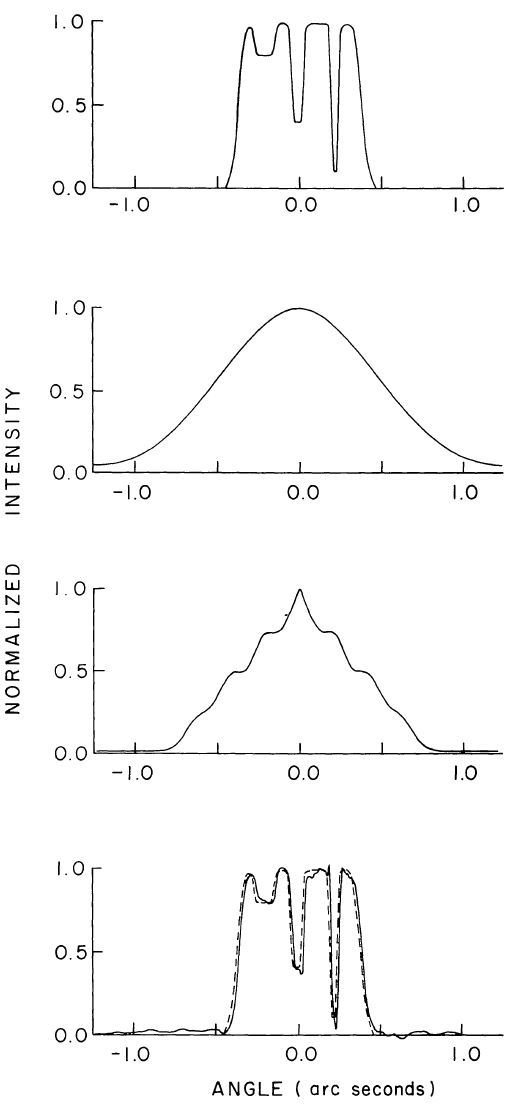
non-symmetric input
long exposure avg
Labeyrie technique
Knox & Thompson method
mean square of the image transform
modulus of the object transform
autocorrelation of the image transform
phase of the object transform
diffraction-limited image of the object
unambiguous reconstruction of arbitrary shapes but has ambiguity
+

The importance of phase in image reconstruction
In 1980’s bispectral analysis was found to have higher S/N and be less susceptible to systematic error.
Weigelt & Lohmann
1977-1983
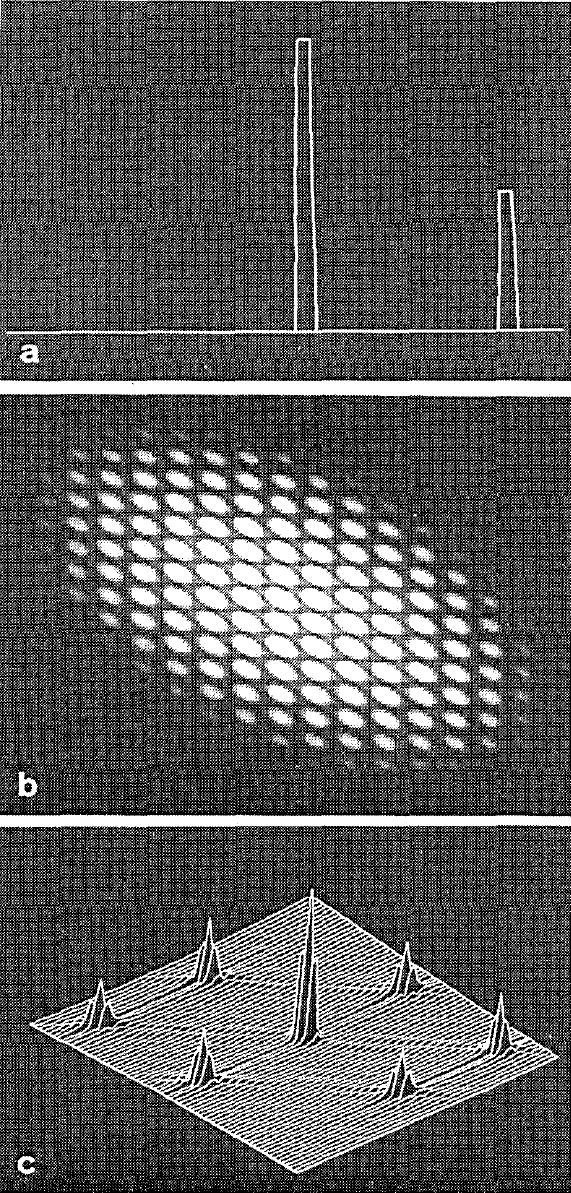
double star simulation
bispectrum modulus
triple correlation
record PSF of object
produce synthetic reference star by shifting the speckle pattern
phase is preserved
Speckle masking/triple correlation theory/bispectral analysis, a 3rd order correlation
deconvolve
true images
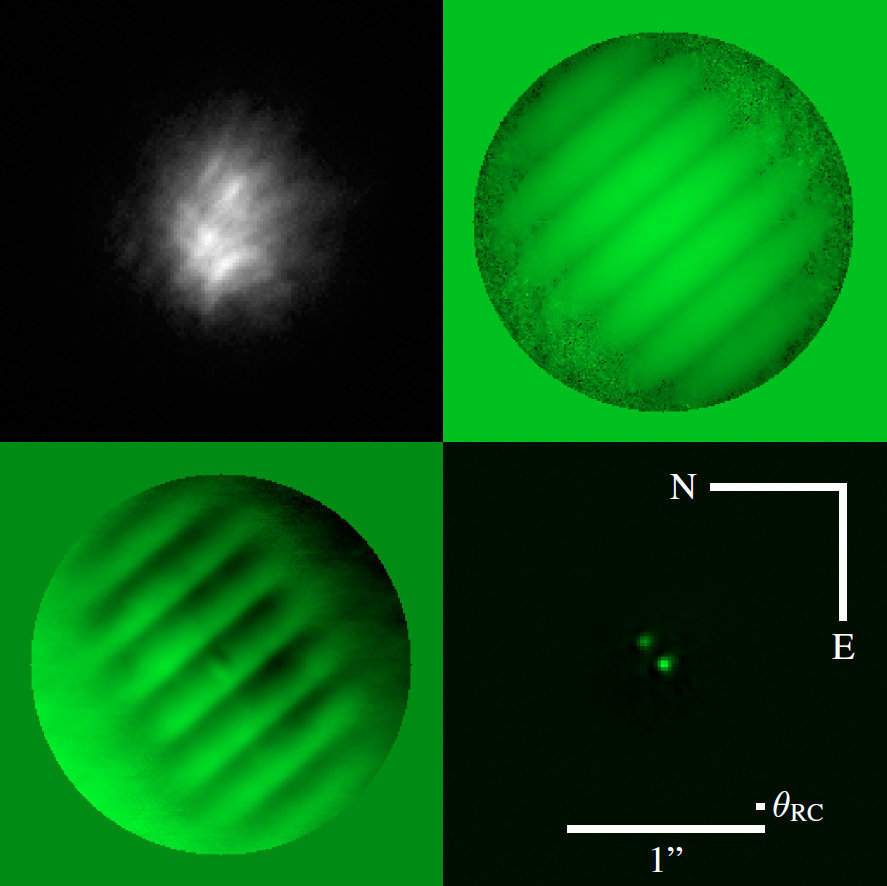
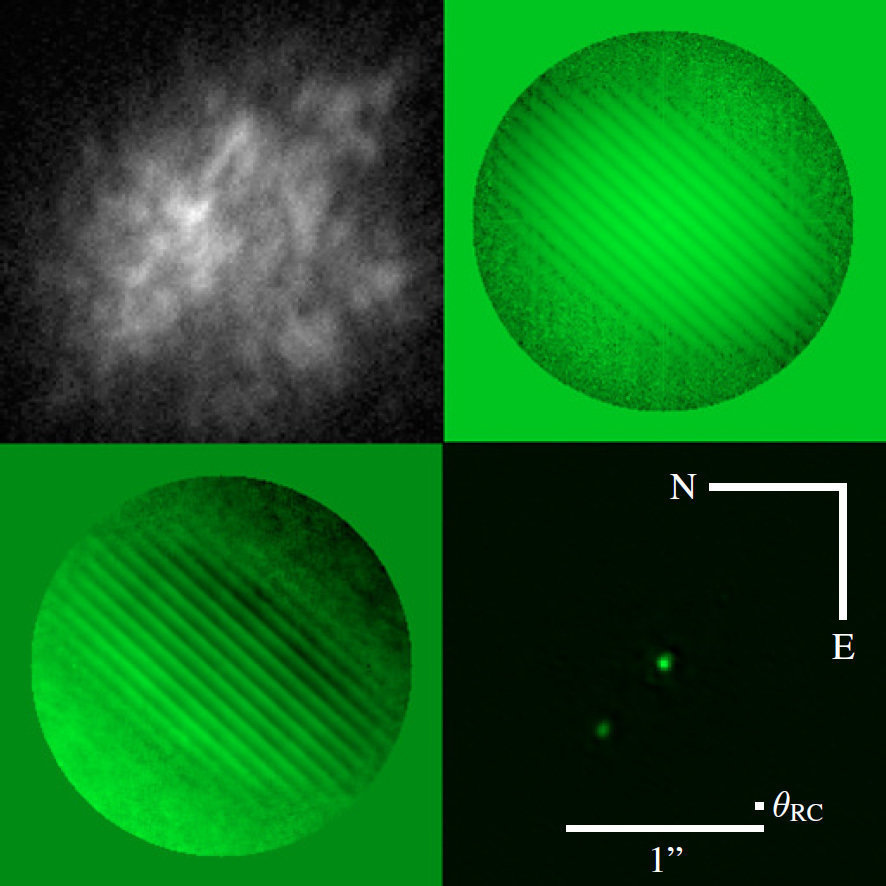
Fringe spacing
Fringe orientation
Fringe Depth
Binary separation
Binary position angle
Binary magnitude difference




1s
40s
20min



An aside on Lucky Imaging
- reaches higher resolution than typical seeing
- does not utilize Fourier analysis
- not capable of reaching the diffraction limit
- requires a very large number of images

http://inspirehep.net/record/823349/plots
Fried
1978
record a large series of images
discard instances of poor resolution
combine the remainder through shift-and-add techniques
Can reach
Changes in technology
ICCDs


EMCCDs
- CCD + image intensifier tube
- amplify signal prior to ADC
- tube gating and amplification
- up to 500kHz
- lower resolution and low QE
- interline detector 50% QE
- CCD + series of HV gain registers
- + photoelectric events w/ each register
- greatly amplified signal w/ single readout of the array
- 2008: Tokovinin published the first speckle imaging results
- frame transfer, QE > 90%, low readout noise
- higher S/N than ICCDs
- 10-100 times faster than a CCD

- active pixel sensor: amplification and conversion happens directly on each pixel
- cheap, less power and lower gain needed
- higher S/N,
- fast readout
- no clocking the charge across the array
- further on-chip processing can be added
CMOS (complementary metal–oxide–semiconductor)
EMCMOS
- each pixel has a series of HV registers
- + photoelectric events w/ each register


2015: first EMCMOS results reported by Brugière
Publications
SAO/NASA ADS “Bumblebee” search: ‘‘speckle’’ - ‘‘speckle noise’’
- limited to astronomy and refereed
- removed AO speckle noise references
- excluded AO and spectroscopic techniques
- constrained to 1970+ sorted by citation count
This search returned 1,139 papers with 26,624 total citations
release of EMCCDs
& start of large speckle survey programs.


Instrument Programs -
- often non-hierarchical or bottom-up
- if successful, use may spread to the broader community
- many for a specific use and have a finite lifespan
- limitations of the technology or availability of people
- many have quiescent phases
- information is limited to what is publicly available (update your websites)
The following table lists current or recently active major optical speckle imaging programs along with a few IR speckle and lucky imaging instruments and selected other high-resolution programs.
Disclaimer
Title Text
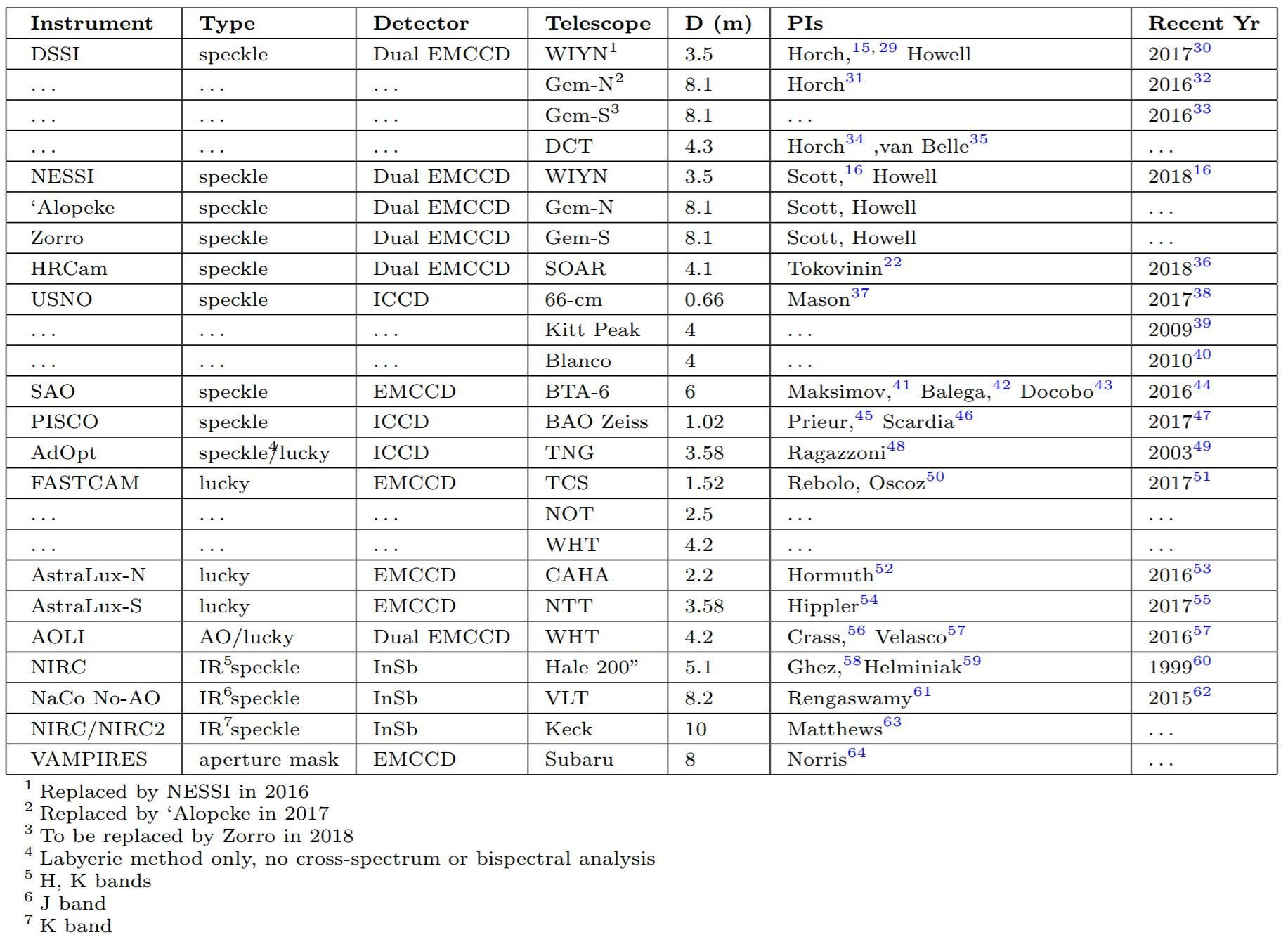
Title Text

Text

|
Source: Wikimedia
|
|


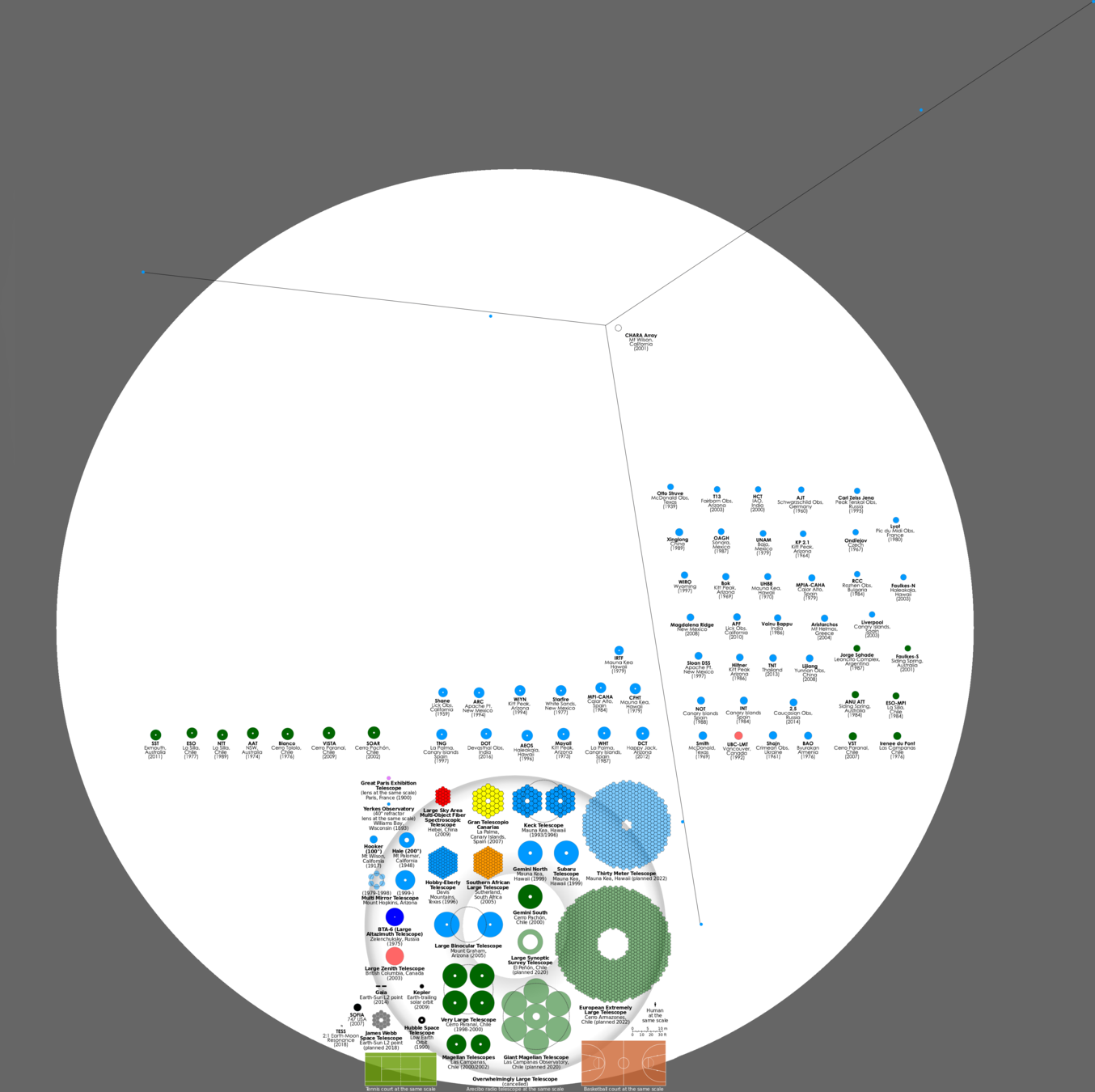
DSSI/NESSI/`Alopeke/Zorro









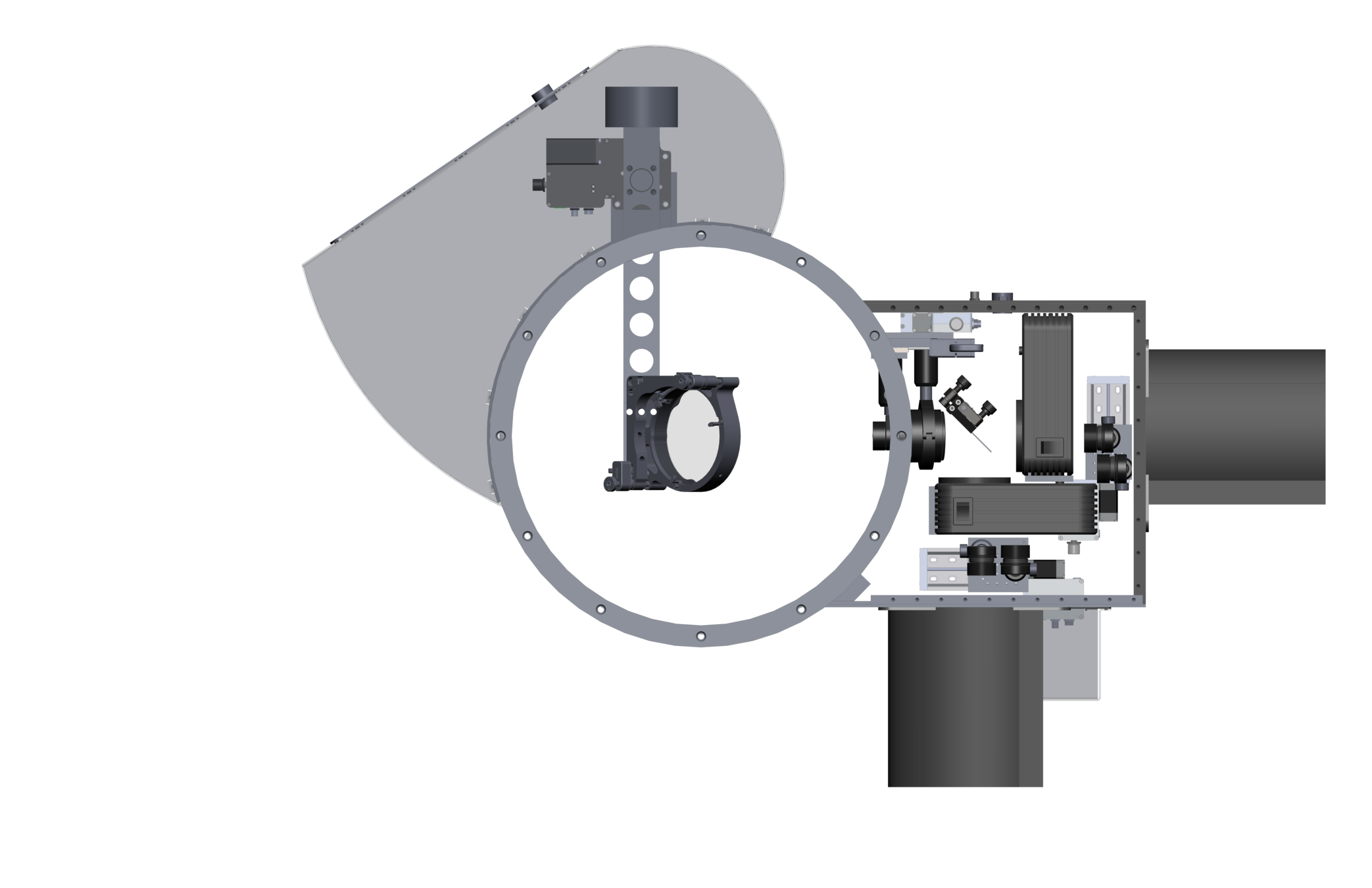







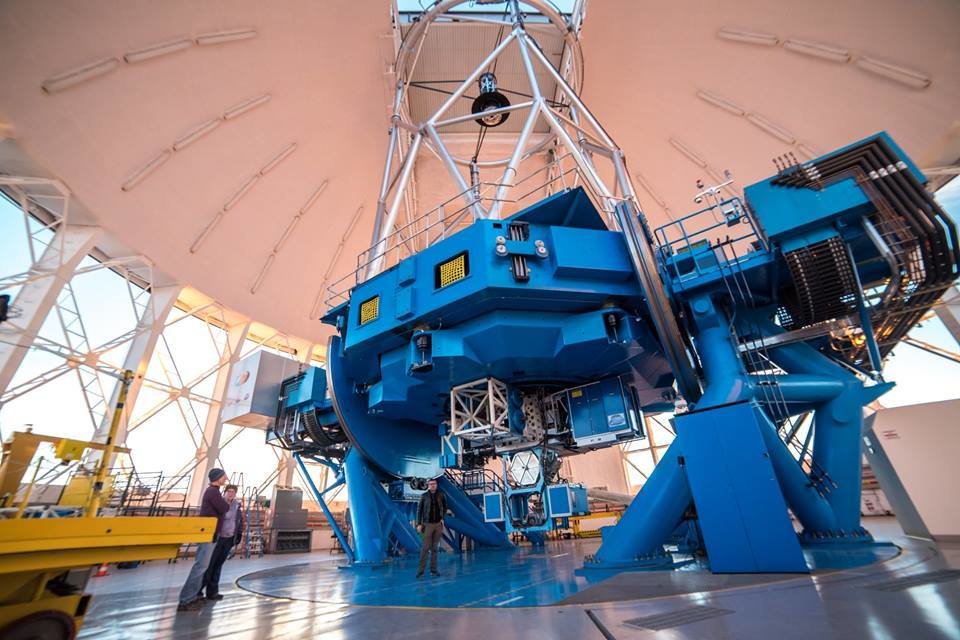







Speckle
- 10mas/pxl
- mag limit ~17
- contrast limit ~8
Wide Field
- 73mas/pxl
Speckle
- 18mas/pxl
- mag limit ~14
- contrast limit ~6
Wide Field
- 81mas/pxl


0.011'' @u
0.026'' @832nm
0.025'' @u
0.060'' @832nm
6.7''
60''
19''
56''
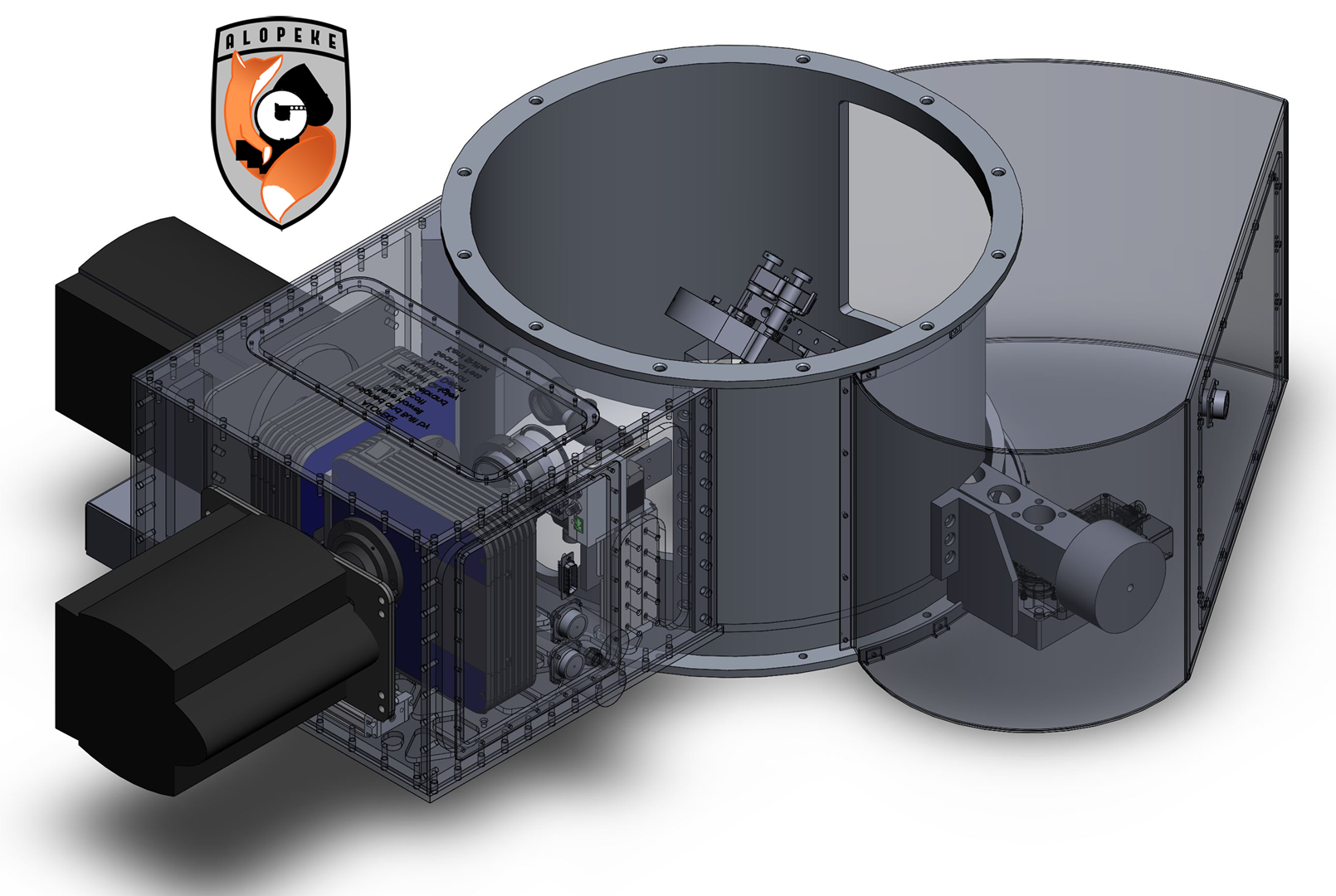
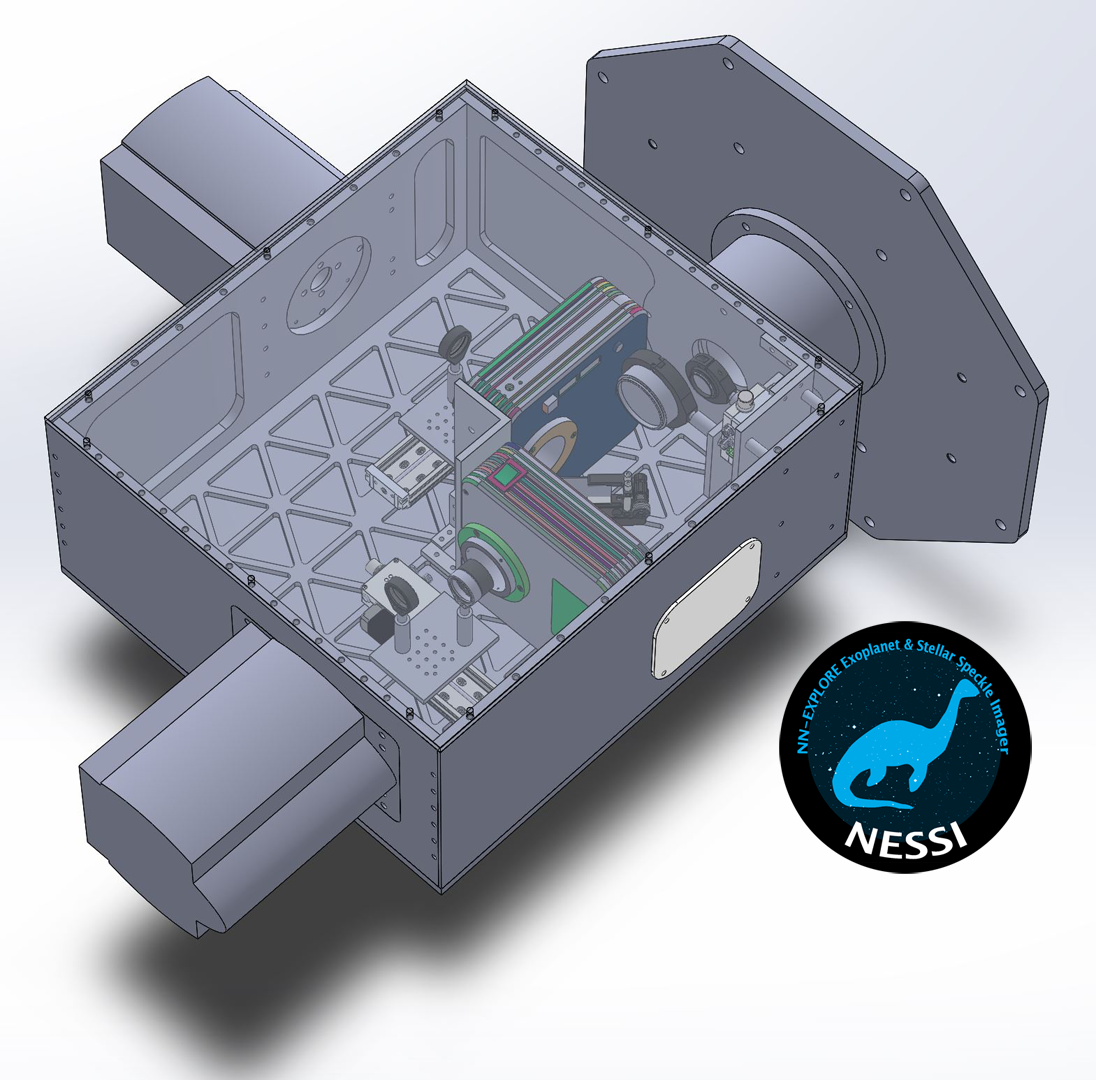




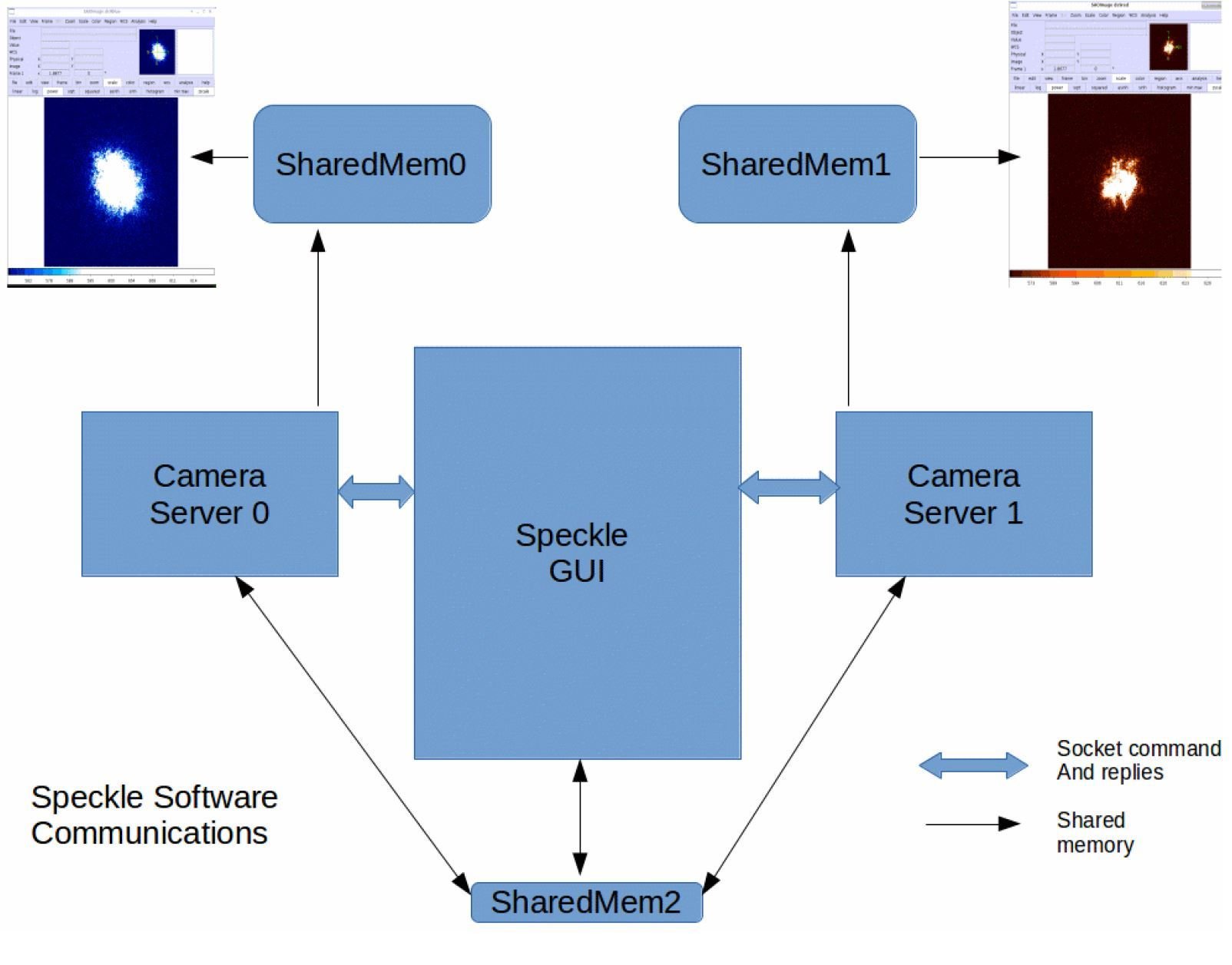
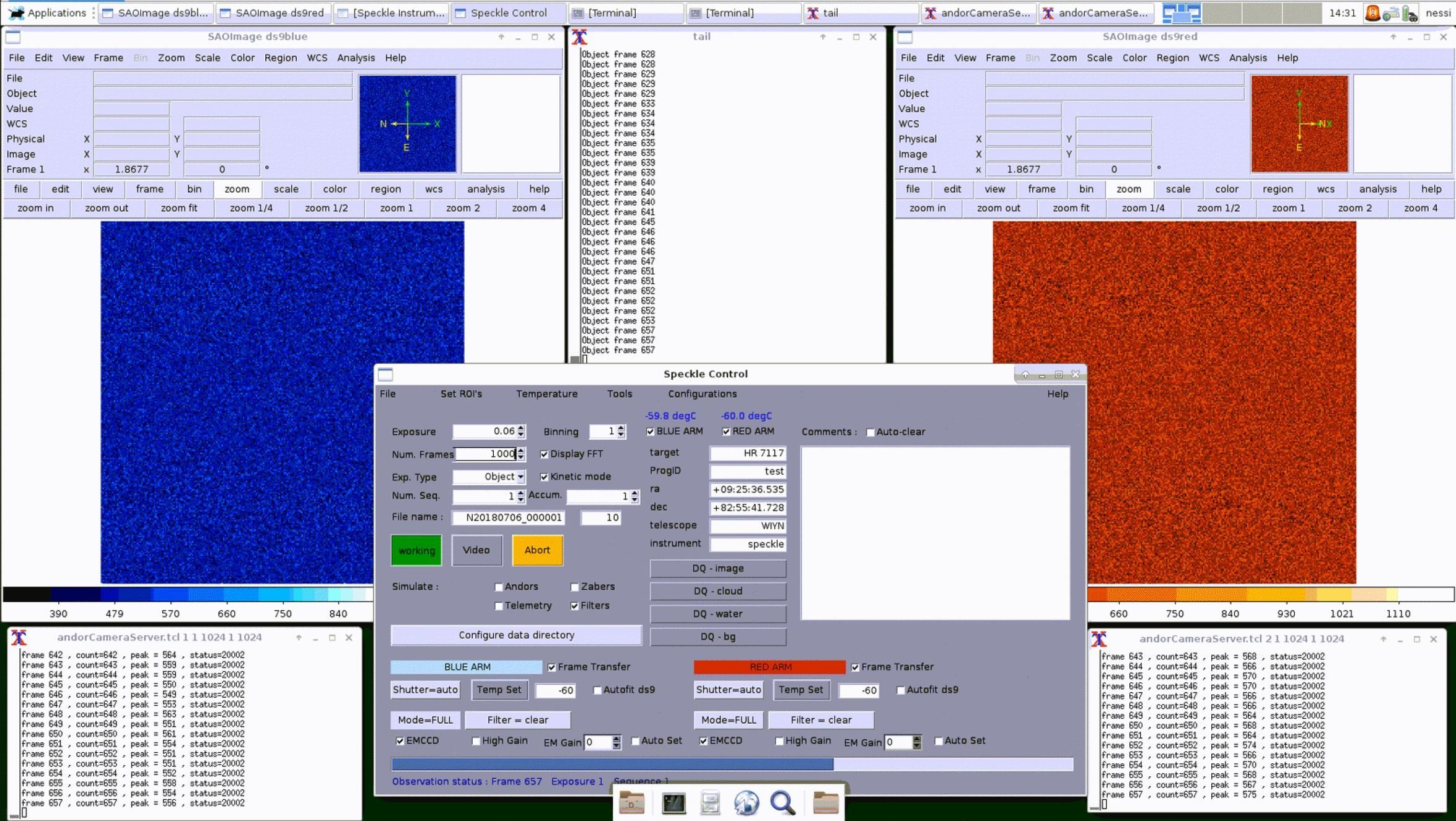
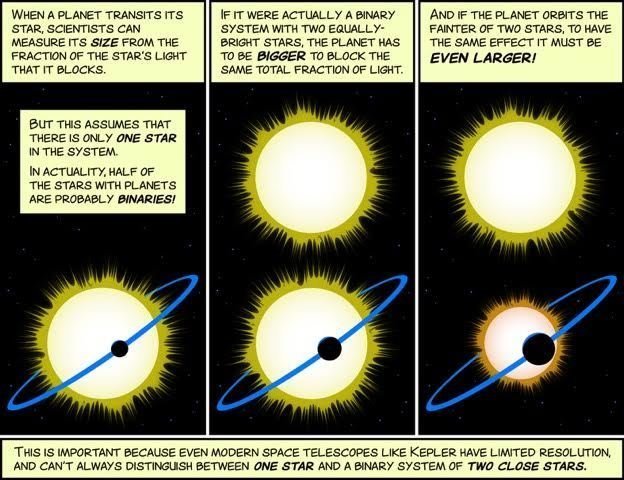


Science Programs
58 total proposals
138.3 total nights
(NOAO 2016A to 2019B)

- Constrain NEA diameters. Image SS objects
- Determine multiplicity of nearby K and M-dwarfs, does it vary across spectral type?
- Imaging of brown dwarfs and distant large planets, particularly around M dwarfs
- Investigate differences in planetary system architectures between multiple vs not (known) multiple host stars
- Examine long-term RV trends/determine binarity of RV planet hosts.
- K2, TESS follow-up
- Provide an unbiased sample for TESS, so statistical determinations of planet occurrence rates can be made
- Occultations, transit photometry, pulsar time scales, observe pulsating WDs at high cadence
- Interacting binary systems, jets, CVs, R Aquarii
- WR stars - jets, outflows
Some proposals:


HST R Aquarii
Science Results Highlights


- optical, NIR imaging of host stars of KOIs
- ~ 90% of the confirmed & candidate exoplanet hosts
- separations, PA, and dm for all detected, bound and LoS companion stars.
-
2297 companions around 1903 primary stars
- ~ 10% obs stars 1+ companions w/i 1”
- ~ 30% w/i 4”
-
correction factors for exoplanet radii caused by the dilution of the transit depth
- decreases the number of KOI planets with radii smaller than 2 Earth radii by 2% - 23%

Furlan's previous results applied to planets w/ known masses & radii, analyze the effects of a close stellar companion on planetary density.
- 50 planets orbiting 26 stars in the Kepler field
- transit dillution planet radii , planet density
- with faint companion star, density may decrease by ~ 3x
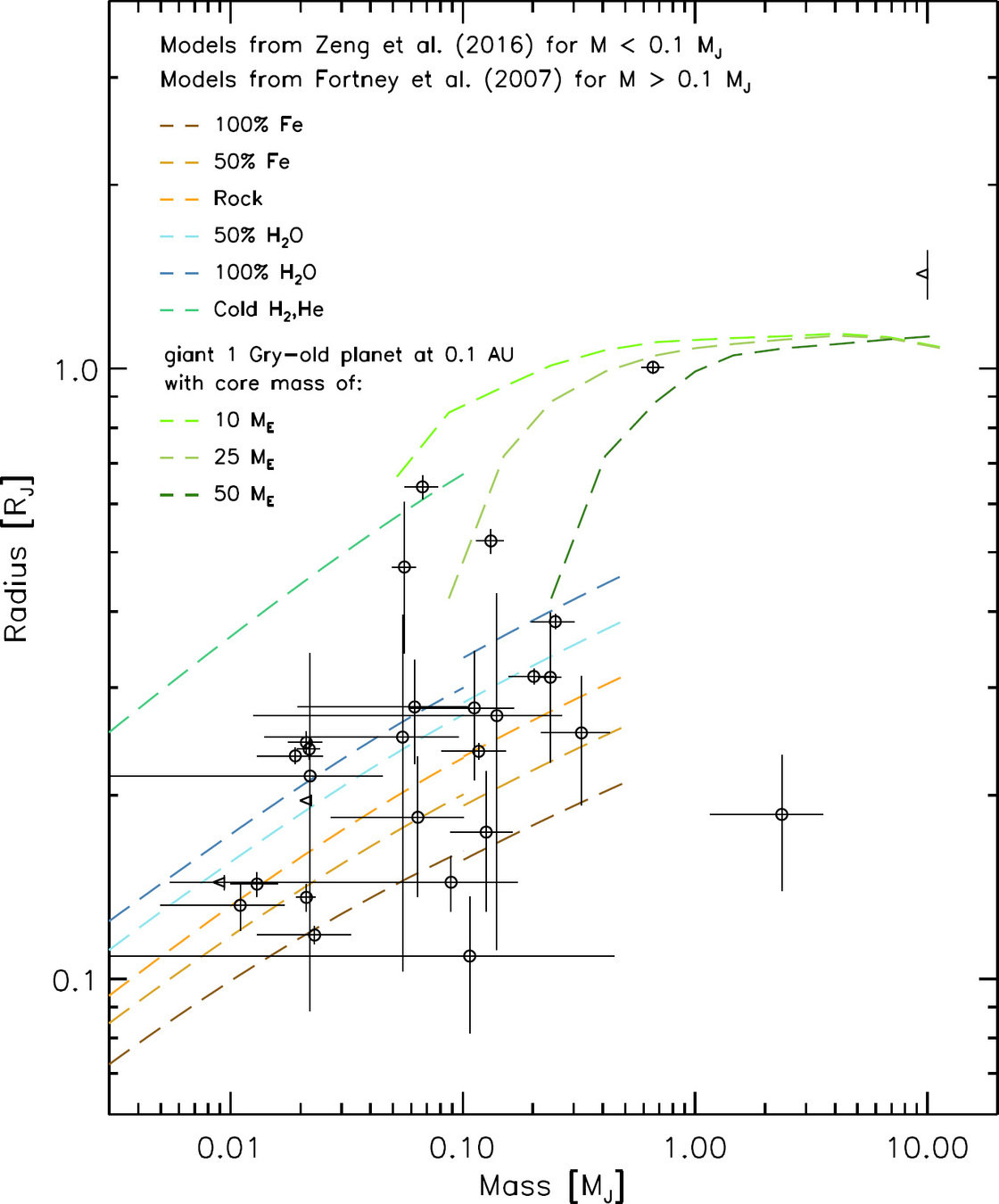



close ~ 0.5” companions of Kepler and K2 planet candidate hosts and the inferred exoplanet radius distribution.
- Fulton gap is robust regarding undetected stellar companions
- gap became broader & shallower when accounting for possible undetected stellar companions
- core composition of super-Earth and sub-Neptune exoplanets may not have so strong a divide as is suggested initially
- w/o high-resolution imaging of Kepler and TESS host stars, the exoplanet radius distribution will be incorrectly inferred.

Fulton
mini-neptunes
super-Earths
- Large radius errors originally hid distribution features
- Fulton gap revealed after CKS (10% stellar radius errors)
- Accounting for binarity shifts gap in the distribution

brightest companion 1''
brightest companion 2''
Shift from 1.8 to 2.2
- increased water/ice vs pure Si rock

- 170 KOI companions < 2”
- AO, speckle, lucky, or HST
- constrained stellar properties
- assessed the probability that the companions are physically bound
- 60 - 80% of companions < 1”
- > 90% of companions < 0.5” were found to be bound
- assuming the planet is equally likely to be orbiting the primary or secondary, unless they are vetted, nearly half of all Kepler planets may have radii underestimated by an average of 65%.


- DSSI @ G-S
- highest-resolution images to date
- 27 mas
- imaging from 0.32 to 14.5
au - excludes all possible stellar and brown dwarf companions



- Detection % vs. projected angular separation for TRAPPIST-1.
- 5σ detection limit convolved with the detection likelihood.
- eliminates all companions in the blue region
- separations of 0.32–17 au
- Numbers are the dmag & spectral type limits at the corresponding points.
- ex. all companions earlier than T7 are eliminated < ∼8 au.
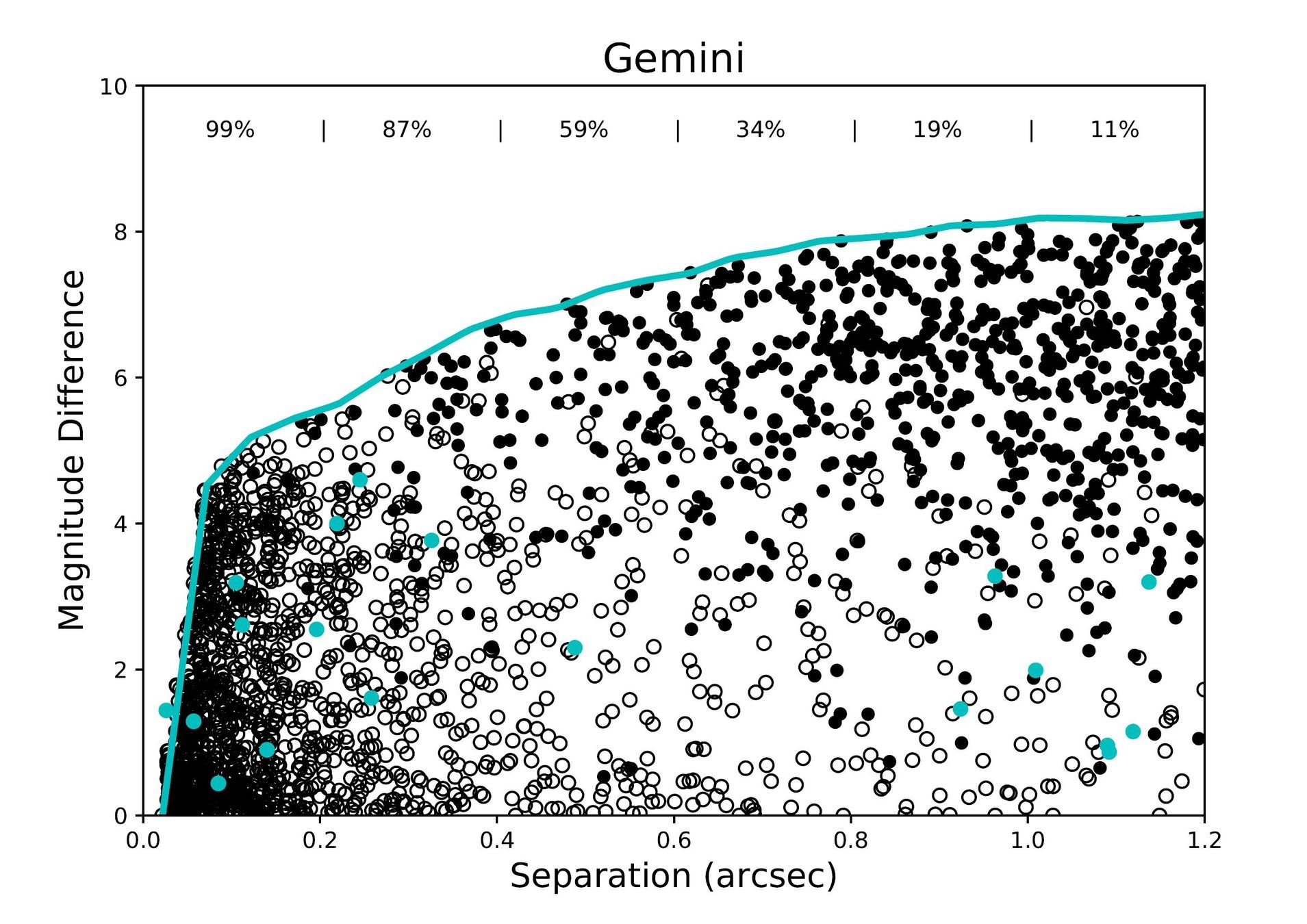
observed
bound (simulated)
line-of-sight (simulated)
K2 binaries detectable with DSSI-

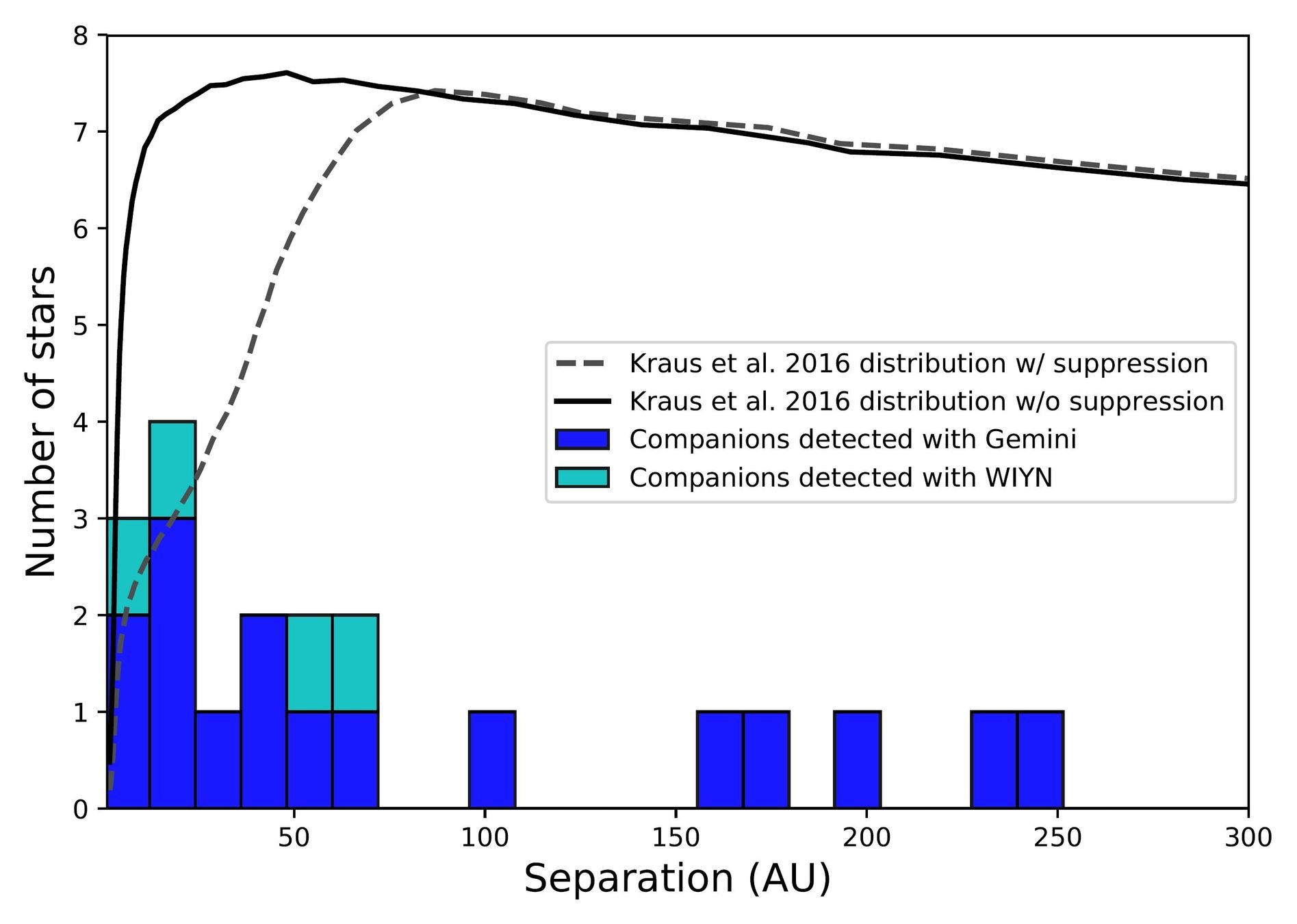


- Speckle imaging can detect potential companions to the left of the dashed lines
- eliminating companions that may cause false positives or dilute transits.
- Solid gray lines show the contrast ratios at which planet radii will have 1% and 0.1% correction factors due to the presence of a stellar companion.
Future
- Quad-channel
- Wave-front sensing
- Possible near-IR channel?
- DSSI heritage at the DCT+NPOI
- novel construction
QWSSI

PI: van Belle
NEAs
- sizes
- radar typically quotes 40% uncertainties
- albedo/radar size mismatch
- shapes
- adapt stellar surface modeling tools
- light curve inversion/illumination model

a~2.8AU
d~270km x 80km
(neck~50-65km)

model: Franck Marchis


Phaethon
Dec 2017 ~ 0.07AU
d~6km


Point source PS
Phaethon power spectrum (resolved)

Seeing-limited
Reconstructed

42''
Two-color wide-field speckle reconstruction
from NESSI
- 0.25'' resolution from 500 frames (20s)
- compromise b/t angres and contrast
- Seeing ~ 0.85''




3-4x improvement over native seeing

Reconstruction
coming
Text
Text


M13
- astrometry of clusters
- very early results and little calibration or modelling over the FoV
Reconstructed
Seeing-limited
Abs astrometry residuals
~6-7 mas
4.2 mas
Further improvement possible to obtain ~0.02 pix (~0.4mas)
- optics, dither, deeper obs
0.05 mag accuracy on aperture photometry
FWHM ~7pix (0.57'')
FWHM ~4pix (0.3'')
Pluto opposition
SOFIA occultation target duplicity


WF and speckle optics
Conv and EMCCD imaging
466/832 and g/i filters
TNO Varda ⌀~700km, d~50au
multiplicity is the single largest source of error to occultation path prediction


next steps: grisms & h-alpha filters

- observe jets of Wolf-Rayet stars in h-alpha compared to "continuum" SDSS
HST WR 124

- leverage the 0.01"/pixel plate scale of the instruments
- extremely sensitive EMCCD, large aperture (Gemini), low-dispersion grism
- sci case1: high-z transients, GRBs
- sci case2: exoplanet host flares
Conclusions
- a brief history and introduction has attempted to set the stage for the current research
- highlighting the relevance of high angular resolution imaging to exoplanet and stellar research
- high demand for speckle imaging observing
- development of future community instruments
- small space telescopes, optimized for large surveys of the sky, like TESS and GAIA, perform relatively poorly at high-contrast, sub-arcsecond resolution where speckle imaging excels
- a cost-effective, efficient means to reach the diffraction limit with single aperture telescopes
Open to the community
- NOAO proposal process
- NESSI - WIYN@KPNO
- `Alopeke - Gemini-N
- Zorro - Gemini-S
- Transitioning from block queue operation to Facility Instrument status
Additional References
Brown, R. H. and Twiss, R. Q., Nature 177, 27{29 (Jan. 1956).
Hanbury Brown, R., Davis, J., and Allen, L. R., MNRAS 137, 375 (1967).
Labeyrie, A., A&A 6, 85 (May 1970).
Knox, K. T. and Thompson, B. J., ApJ 193, L45{L48 (Oct. 1974).
Weigelt, G., Scientifc Importance of High Angular Resolution at Infrared and Optical Wavelengths, Ulrich, M. H. and Kjaer, K., eds., 95{114 (1981).
Weigelt, G., Lowell Observatory Bulletin 9, 144{152 (1983).
Weigelt, G. P., Optics Communications 21, 55{59 (Apr. 1977).
Lohmann, A. W., Weigelt, G., and Wirnitzer, B., Appl. Opt. 22, 4028{4037 (Dec. 1983).
Fried, D. L., Journal of the Optical Society of America (1917-1983) 68, 1651–1658 (Dec. 1978).
Horch, E. P., Veillette, D. R., Baena Galle, R., Shah, S. C.,O'Rielly, G. V., and van Altena, W. F., AJ 137, 5057{5067 (June 2009).
Brugière, T., Mayer, F., Fereyre, P., Gu´erin, C., Dominjon, A., and Barbier, R., Nuclear Instruments and Methods in Physics Research A 787, 336–339 (July 2015).
Scott, N. J., Howell, S. B., Horch, E. P., and Everett, M. E., PASP 130, 054502 (May 2018).
Hofmann, K.-H. and Weigelt, G., A&A 278, 328-339 (Oct. 1993).
Law, N. M., Mackay, C. D., and Baldwin, J. E., A&A 446, 739{745 (Feb. 2006).
Tokovinin, A. and Cantarutti, R., PASP 120, 170 (Feb. 2008).
Andor, CCD, EMCCD and ICCDComparions & Minimizing Clock Induced Charge.
Howell, S. B., Everett, M. E., Sherry, W., Horch, E., and Ciardi, D. R., AJ 142, 19 (July 2011).
Furlan, E., Ciardi, D. R., Everett, M. E., Saylors, M., Teske, J. K., Horch, E. P., Howell, S. B., van Belle, G. T., Hirsch, L. A., Gautier, III, T. N., Adams, E. R., Barrado, D., Cartier, K. M. S., Dressing C. D., Dupree, A. K., Gilliland, R. L., Lillo-Box, J., Lucas, P. W., and Wang, J., AJ 153, 71 (Feb. 2017).
Furlan, E. and Howell, S. B., AJ 154, 66 (Aug. 2017).
Teske, J. K., Ciardi, D. R., Howell, S. B., Hirsch, L. A., and Johnson, R. A., ArXiv e-prints (Apr. 2018).
Fulton, B. J., Petigura, E. A., Howard, A. W., Isaacson, H., Marcy, G. W., Cargile, P. A., Hebb, L., Weiss, L. M., Johnson, J. A., Morton, T. D.,Sinuko , E., Cross eld, I. J. M., and Hirsch, L. A., AJ 154, 109 (Sept. 2017).
Hirsch, L. A., Ciardi, D. R., Howard, A. W., Everett, M. E., Furlan, E., Saylors, M., Horch, E. P., Howell, S. B., Teske, J., and Marcy, G. W., AJ 153, 117 (Mar. 2017).
Matson, R. A., Howell, S. B., Horch, E. P., Everett, M. E., ArXiv e-prints (May. 2018)